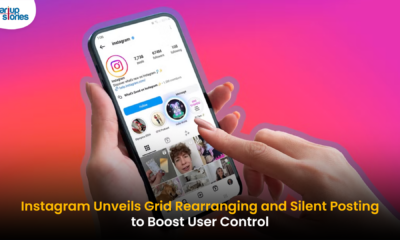Latest News
Instagram Rolls Out AI Studio, Letting Users Create Personal AI Avatars!

Meta is introducing a new tool called AI Studio, enabling users in the U.S. to create AI-powered versions of themselves on Instagram and the web. This feature allows creators and business owners to develop customized AI profiles to interact with followers on their behalf, including replying in chat threads and responding to comments on their accounts.
Overview of AI Studio
Meta’s AI Studio offers various customization options, allowing creators to design their AI personas based on preferred Instagram content, topics to avoid, and links to share. The tool also includes an auto-reply feature, giving users control over which accounts can interact with their AI.
Customization and Functionality
AI Studio supports the creation of new, themed AI characters that can be used across Meta’s platforms, similar to popular chatbots from companies like Character.AI and Replika. Users can customize their AI avatars by selecting names, personalities, and even specific responses to certain inquiries. This flexibility allows for a more personalized interaction experience.
Features and Benefits
With AI Studio, Instagram creators can set up an AI as an extension of themselves that can quickly answer common DM questions and story replies. Whether it’s sharing facts about themselves or linking to their favorite brands and past videos, creator AIs can help reach more people while providing faster responses.
Key Features
- Customization Options: Users can define their AI’s personality traits, interests, and response styles.
- Auto-Reply Functionality: Creators can automate responses to frequently asked questions.
- Transparency: Responses from creator AIs are clearly labeled as being generated by an AI, ensuring transparency for followers.
Addressing Concerns with AI Responses
Meta acknowledges the potential for unintended responses from these AI avatars. To mitigate risks, the company has implemented guidelines advising creators to carefully curate topics their AI won’t discuss. For example, sensitive subjects such as financial advice or personal health issues should be avoided.
User Guidelines
Creators are encouraged to specify topics to avoid by including instructions such as “You REFUSE to discuss [insert topic].” This proactive approach aims to prevent misunderstandings and maintain a positive interaction environment for users.
Initial Experiments with AI Avatars
Meta initially experimented with AI avatars by partnering with celebrities to create versions of themselves with modified names and personas. This approach allowed the company to test the waters of AI-generated interactions while managing the risks associated with public figures responding through automated systems.
Celebrity Collaborations
Some notable examples include chatbots created by celebrities that engage users in specific contexts—such as offering dining recommendations or sharing travel tips—further showcasing the versatility of the platform.
Future Prospects
Although currently available only in the U.S., Meta plans to expand access to AI Studio across its platforms, including WhatsApp and Messenger. The company aims to enhance user engagement through these personalized interactions while continuing to refine its underlying technology.
Upcoming Developments
As Meta rolls out this feature more broadly, it will be interesting to see how users adopt these tools for personal branding and engagement strategies. The potential for creating unique digital companions could reshape how creators interact with their audiences online.
Conclusion
With the launch of AI Studio, Meta is positioning itself at the forefront of personalized digital interaction. By allowing users to create tailored AI avatars that reflect their personalities and preferences, the company is enhancing user engagement while addressing concerns about responsible usage.
As this technology evolves, it will be crucial for Meta to monitor user feedback and adapt its tools accordingly, ensuring that they remain beneficial for both creators and their audiences in an increasingly digital landscape.
Latest News
Zerodha Reports 23% Profit Decline in FY25 as Revenues Miss Target

Zerodha experienced a challenging FY25, as its revenue fell 11.5% to ₹8,847 crore and net profit dropped 22.9% to ₹4,237 crore. This decline reflects tougher regulatory conditions, lower trading volumes, and increased operational costs in the brokerage market, all of which impacted core earning segments for the company.
Despite these headwinds, Zerodha improved its operating margin to 63.78% and built up significant cash reserves, reporting ₹22,679 crore in bank balances. Salary expenses and director remuneration increased, but disciplined cost controls helped the company maintain profitability and a debt-free balance sheet. The drop in active clients and increased compliance costs further contributed to the profit contraction.
Looking ahead, Zerodha’s resilience is supported by its robust cash position and operational efficiency. Maintaining steady margins, diversifying product offerings, and investing in technology positions the company to withstand future regulatory fluctuations and changing market sentiment reinforcing its status as one of India’s leading brokerage firms.
Latest News
Zoho Pay Debuts as India’s New UPI Challenger, Taking on PhonePe, Paytm, and Google Pay

Zoho Corporation has expanded its fintech portfolio with the launch of Zoho Pay, a UPI-based payments app built to challenge India’s top digital payment giants such as PhonePe, Paytm, and Google Pay. The new app supports peer-to-peer transfers, bill payments, QR-based transactions, and merchant settlements in a streamlined interface. Available as both a standalone app and an integrated feature inside Zoho’s privacy-driven messenger Arattai, Zoho Pay enables users to handle chats and payments in one platform, emphasizing data privacy and Made-in-India innovation.
Through seamless integration with Arattai, Zoho Pay allows users to send or request payments, split expenses, and conduct UPI-based transactions directly in their chat windows. Users can link bank accounts, scan dynamic QR codes, and receive audio confirmations of payments, ensuring speed and security. This design mirrors the simplicity of India’s leading UPI apps but is powered by Zoho’s non-advertising, privacy-first model. The integration aligns with Zoho’s mission to build a self-reliant digital ecosystem, where messaging and money management coexist securely.
In the competitive digital payments market, Zoho Pay differentiates itself through its tight business software integration with apps like Zoho Books, Zoho Payroll, and Zoho Commerce, offering small businesses unified access to payments, billing, and accounting. The company is also expanding its reach with POS devices for merchants featuring UPI QR, card payments, and instant reconciliation tools. With founder Sridhar Vembu’s vision of a ‘Chat + Pay’ ecosystem, Zoho Pay reflects a bold step toward redefining India’s fintech scene with a secure, ad-free, and locally developed alternative to global payment platforms.
Latest News
Meta Expands AI-Powered Reels Translation to Hindi and Portuguese, Enhancing Global Creator Reach

Meta has expanded its AI-powered translation feature for Reels to include Hindi and Portuguese, joining English and Spanish in empowering creators to reach a broader global audience on Instagram and Facebook. Originally launched in August 2025 with support for English and Spanish, this update now allows creators to seamlessly translate and dub their short videos, breaking language barriers across some of the largest Reels markets worldwide. The AI technology mimics the creator’s voice tone and even offers lip-syncing to ensure the translated videos feel natural and engaging for viewers.
This enhancement is especially significant for India, the largest market for Facebook and Instagram, where over 600 million people speak Hindi. Content creators who are not fluent in Hindi can now easily access this vast audience, increasing their reach and engagement across diverse linguistic groups. To maintain transparency, all translated Reels are clearly labeled with “Translated with Meta AI,” and viewers can choose to switch translations on or off based on their preference.
In addition to voice dubbing, Meta is developing features to translate captions and text stickers on Reels, making content more accessible even without sound. These AI translation tools are available free for eligible public Instagram accounts and Facebook creator profiles with over 1,000 followers. This innovation reinforces Meta’s commitment to fostering cross-cultural content sharing and enhancing creators’ ability to connect with audiences around the world through short-form videos.














create a binance account
April 6, 2025 at 6:44 pm
I don’t think the title of your article matches the content lol. Just kidding, mainly because I had some doubts after reading the article.
Danielemode
May 28, 2025 at 3:10 pm
https://biotpharm.com/# buy antibiotics over the counter
binance
July 22, 2025 at 4:11 pm
Your article helped me a lot, is there any more related content? Thanks!
binance
September 4, 2025 at 2:42 am
Thank you for your sharing. I am worried that I lack creative ideas. It is your article that makes me full of hope. Thank you. But, I have a question, can you help me?
Jamesdig
October 11, 2025 at 10:37 am
https://medivermonline.com/# low-cost ivermectin for Americans
ivermectin paste 1.87 dosage for dogs
XavierThafe
October 11, 2025 at 7:31 pm
ivermectin fenbendazole: trusted Stromectol source online – Mediverm Online
iwin
November 6, 2025 at 12:07 pm
iwin – nền tảng game bài đổi thưởng uy tín, nơi bạn có thể thử vận may và tận hưởng nhiều tựa game hấp
J88
November 8, 2025 at 6:04 pm
Đến với J88, bạn sẽ được trải nghiệm dịch vụ cá cược chuyên nghiệp cùng hàng ngàn sự kiện khuyến mãi độc quyền.
站群程序
November 8, 2025 at 11:07 pm
搭载智能站群程序,自动化搭建与管理,为SEO项目提供核心驱动力。站群程序
Kuwin
November 12, 2025 at 12:16 am
kuwin sở hữu kho game đa dạng từ slot đến trò chơi bài đổi thưởng, mang đến cho bạn những giây phút giải trí tuyệt vời.
ios超级签
November 13, 2025 at 11:04 am
苹果签名,苹果超级签平台,ios超级签平台ios超级签苹果企业签,苹果超级签,稳定超级签名
IndianPlets
November 15, 2025 at 7:25 pm
IndiavaMeds: indian pharmacy – drugstore online
GO88
November 19, 2025 at 8:03 am
Tham gia cộng đồng game thủ tại Go88 để trải nghiệm các trò chơi bài, poker phổ biến nhất hiện nay.
binance referral code
November 21, 2025 at 1:41 pm
Your point of view caught my eye and was very interesting. Thanks. I have a question for you. https://www.binance.info/register?ref=IHJUI7TF
MM88
November 30, 2025 at 6:54 am
Với giao diện mượt mà và ưu đãi hấp dẫn, MM88 là lựa chọn lý tưởng cho các tín đồ giải trí trực tuyến.